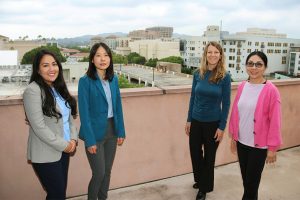 Uncovering links between air pollution and COVID-19
Uncovering links between air pollution and COVID-19
Air pollution affects the health of millions of people around the world. It may increase the risk or severity of many different conditions, such as stroke, asthma, pneumonia, and lung cancer.
Now, Kaiser Permanente Southern California researchers and their collaborators are discovering links between air pollution and COVID-19.
In one investigation, researchers applied high-resolution air pollution models to estimate individual exposure levels for more than 20,000 Kaiser Permanente Southern California members who had been hospitalized for COVID-19. They found that greater exposure to several different pollutants — including fine particles (PM2.5) — was associated with a greater risk of death from COVID-19. This study was published in January 2023 in Environment International.1
“The most important message is that air pollution does matter for COVID-19 mortality,” said Claudia Nau, PhD, a research scientist in the Division of Behavioral Research in the Department of Research & Evaluation, who helped lead the analysis alongside Deborah Rohm Young, PhD, MBA, director of the Division of Behavioral Research.
Dr. Nau noted that air pollution is just one of many risk factors that could be addressed to reduce COVID-19 deaths. Nonetheless, she said, “Our study adds to mounting evidence that air pollution is bad for our health, and with the future possibility of more respiratory disease outbreaks, it is yet another reason to reduce air pollution.”
The study was a collaboration with researchers from the University of California, Los Angeles; UC Davis; UC Berkeley; and the Canadian government. It was funded by the California Air Resources Board, meaning the findings could directly inform future policymaking.
Meanwhile, Anny H. Xiang, PhD, MS, director of the Division of Biostatics Research at Research & Evaluation, was one of the first researchers who received supplemental funding from the National Institute of Environmental Health Sciences to assess connections between air pollution and COVID-19.
Dr. Xiang and her collaborators from the University of Southern California and Sonoma Technology have now published 4 studies on the topic. Dr. Xiang is senior author for all 4 studies. Margo Sidell, ScD, MSPH, a collaborative biostatistician research scientist in the Division of Epidemiologic Research in Research & Evaluation, co- led the data extraction, analyses, and publications.
Like Dr. Nau’s study, these projects harnessed fine-resolution exposure data based on people’s residential addresses.
“Most other studies have used larger-scale data,” Dr. Xiang said. “By using individual-level data and accounting for demographics and health history, we are addressing many weaknesses of previous studies and contributing a lot more to the current knowledge on this topic.”
In the first study, her team found that exposure to traffic-related air pollution was associated with a higher risk of COVID-19 severity and death for 75,010 Kaiser Permanente Southern California members. This study was published in December 2021 in Environment International.2
Another study, of 4.6 million patients, linked both long-term and short-term exposure to PM2.5 and nitrogen dioxide with a higher risk of COVID-19 infection. This study was published in May 2022 in Environmental Research.3
Yet another linked PM2.5 and nitrogen dioxide exposure with worse COVID-19 outcomes and a higher risk of death among 74,915 patients. It was published in August 2022 in the American Journal of Respiratory and Critical Care Medicine.4 A fourth showed that COVID-19 vaccination did not appear to mitigate this link among 50,010 patients. It was published in January 2023 in the American Journal of Respiratory and Critical Care Medicine.5
“Even after controlling for race and ethnicity and other socioeconomic variables, exposure to pollutants was associated with worse outcomes,” Dr. Xiang said.
Dr. Nau added that low-income communities and communities of color are more likely to be located near sources of pollution, such as highways. “Addressing air pollution should help address the environmental injustices that impact so many aspects of people’s health, including COVID-19,” she said.
1Jerrett M et al. Environ Int. 2023;171: 107675.
2Chen Z et al. Environ Int. 2021;157:106862.
3Sidell MA et al. Environ Res. 2022;208:112758.
4Chen Z et al. Am J Respir Crit Care Med. 2022;206(4):440-448.
5Chen Z et al. Am J Respir Crit Care Med. 2023;207(2):218-221.





